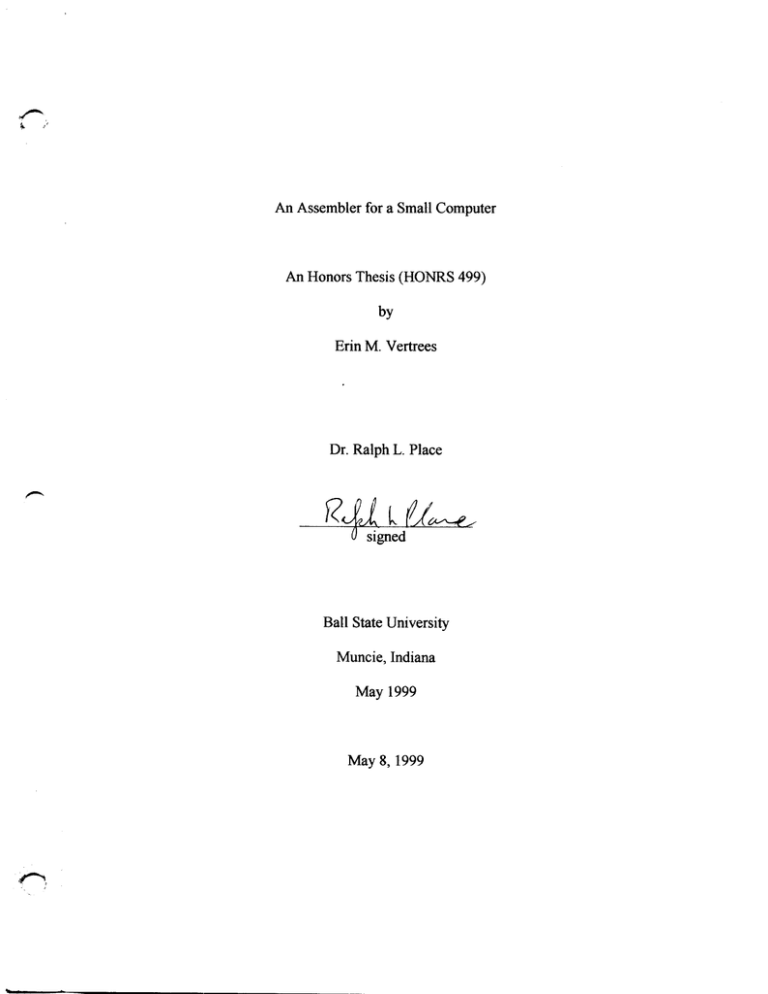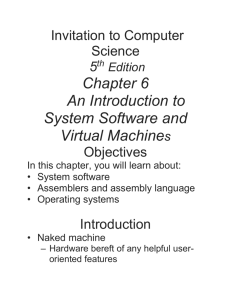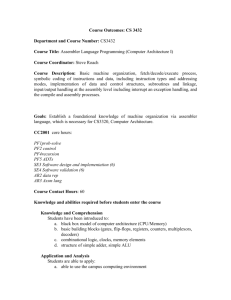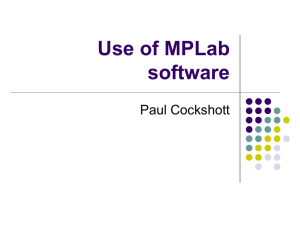Qf!; lV~ L.
advertisement

An Assembler for a Small Computer An Honors Thesis (HONRS 499) by Erin M. Vertrees Dr. Ralph L. Place Qf!; lV~ signed Ball State University Muncie, Indiana May 1999 May 8,1999 .. Abstract i '~11 •ylf-7 This discussion of an assembler for a small computer describes the different instructions that are used by the computer and how these instructions are converted from a symbolic form that is easier for people to write into the binary form that the computer requires. The assembler program included with this discussion reads symbolic codes from a text file and converts them into binary code to be sent to the small computer. The computer itself is based upon the basic computer design outlined in chapter five ofM. Morris Mano' s book, Computer System Architecture, and uses a very reduced set of instructions, compared to normal desktop computers, to carry out operations involving arithmetic and logic functions. Acknowledgements Thank you to Dr. Ralph L. Place, my thesis advisor, who presented me with this project idea and gave me the opportunities to present it to my peers at the Computer Science Open House and at the Undergraduate Research Conference at Butler University. Also, thank you to my fiance, J. Eric Bockelman, who lent me his programming expertise and development software. An Assembler for a Small Computer The assembler for a small computer is part of a larger project that was undertaken by two other students and myself as honors fellowships. For the fall semester of 1998, Dr. Ralph L. Place proposed that the small computer design found in chapter five of M. Morris Mano's book, Computer System Architecture, be built. Once it was finished, a method for giving the small computer tasks to complete was needed. The small computer does not have the traditional method for input and output, such as a monitor and keyboard that normal desktop computers have. Instructions have to be given to the small computer directly in binary format, which is in the form of 0' sand l' s, rather than symbols that people can understand. Therefore, it became my project to develop the assembler - software for the small computer. A computer program is a sequence of instructions that tell the computer what tasks to perform. The language of a program can take a variety of forms, such as machine language, symbolic or assembler language, and high-level language. Machine language instructions are in binary code and are an exact representation of instructions as they appear in computer memory. With symbolic code, the programmer uses symbols consisting of letters, numbers, and special characters, for each of the computer's instructions. E~ch symbolic instruction can be translated directly into a single binary instruction. A special program called an assembler translates the symbolic codes into the binary codes that the computer can understand. As a result, symbolic code is also called assembly language. High-level language programs reflect the procedures used in the 2 solution of a problem rather than with computer hardware. The program that translates a high-level language program to binary is called a compiler (Mano 174-176). Before describing the assembly process, a description of the different kinds of computer instructions and their binary representation is necessary. There are four different types of computer instructions in the assembly language for the small computer. These instructions are memory reference instructions, register reference instructions, input/output instructions, and pseudoinstructions. This fourth group, however, consists of instructions that are not computer instructions but are instructions that give the assembler information about the phase of translation (Mano 180). Each of the other three sets of instructions has a specific code format consisting of sixteen bits. Each bit is a binary digit, zero or one (Mano 132). Memory reference instructions are computer instructions that do exactly as their name suggests. These instructions reference the computer's memory for data to process. The sixteen-bit instruction code for memory reference instructions consists of three parts. Bits four through fifteen contain the binary address of the data to be processed. This twelve-bit address specifies the location in the computer's memory where the data can be found. Bits one through three contain the three-bit operation code that represents the specific memory reference instruction to be executed. The zero bit is called the addressing mode bit. If this bit is set to zero, then the address part of the instruction is called a direct address meaning that this is the address in memory where the data to be processed can be found. If the mode bit is set to one, then the address part of the instruction is called an indirect address. An indirect address specifies the memory 3 - location that contains the address where the data to be processed can be found. It is the address of the address, so to speak (Mano 132). Regist(~r reference instructions and input/output instructions have similar instruction code formats and are grouped together in a category called non-memory reference instructions. Register reference instructions perform operations or tests on the accumulator n~gister of the small computer. Input/output instructions are needed for bringing infonnation in and out ofthe small computer. The sixteen-bit instruction code format of the register reference instructions consists of two parts. Bits four through fifteen represent the register operation to be performed. Bits zero through three identify the instruction as a register reference instruction and always have the value of 0111. The sixteen-bit instruction code for input/output instructions also consists of two parts. Bits - four through f[fteen represent the input/output operation to be performed. Bits zero through three identify the instruction as an input/output instruction and always have the value of 1111 (Mano 132). Pseudoinstructions, as stated earlier, are not true computer instructions. Instead, they are instructions to the assembler about the phase ofthe binary translation. There are four different pseudoinstructions that are used by the assembler for the small computer. The first is the ORG, or origin, pseudoinstruction. This pseudoinstruction informs the assembler that the instruction or operand in the next line of the program is to be placed in the memory location specified by the number that follows the ORG instruction. The next pseudoinstruction is the END pseudoinstruction. END is placed at the end of the symbolic program and tells the assembler that there are no more lines in the program to translate. The final two pseudoinstructions, DEC and HEX, tell the assembler how to 4 - convert the number that follows into a binary number. If the pseudoinstruction is DEC, the number must be converted from a decimal format to binary. If the pseudoinstruction is HEX, then the number that follows must be converted from a hexadecimal format to binary (Mano 180 - 181). Like all languages, programming languages have rules concerning how the instructions ar,e used when writing programs. The assembly language for the small computer also has its own set of rules that must be followed in order for the assembler to correctly translate the symbolic instructions to the sixteen-bit binary instruction codes. Each assembly program written for the small computer must contain three columns or fields that are separated by tabs. The first field is the label field. This field may be empty, or it may specify a symbolic address, or variable name, that will represent a - specific location in the computer's memory. The symbolic address can consist of one to three alphanumeric characters, and a comma must always terminate it. The programmer may determine what this symbol is (Mano 179). The second field in the assembly program is the instruction field. The instruction field specifies a machine instruction or a pseudo instruction. If the instruction is a memory reference instruction, then it occupies two or three symbols that are separated by spaces. The first symbol must be one of the three letter symbols that specify a memory reference operation. The second symbol is one of the symbolic addresses that were defined by the programmer. Each symbolic address that appears in the instruction field, then it must appear again in the label field. The third symbol is optional, and if present, it must be the letter 1. If the I symbol is present, this symbol specifies an indirect address. If it is missing, then it specifies a direct address. If the instruction is a non-memory 5 - reference instruction, it must specify any of the three letter symbols for register reference instructions or input/output instructions. The third field in the assembly program is the comment field, which may be used or left blank. During the binary translation process of the assembler, the comment field is ignored. Comments are for explanation purposes only and help the programmer to describe what each line of his program is doing. In order for the assembler to recognize the comment, it must be preceded by a forward slash (Mano 179 - 181). What follows is an example of an assembly program for the small computer that will subtract two numbers. MIN, SUB, DIF, ORG 100 LDASUB CMA INC ADD MIN STADIF HLT DEC 83 DEC-23 HEX 0 END IOrigin of program is location 100 !Load subtrahend to AC ICompiement AC IIncrement AC IAdd minuend to AC IStore difference !Halt computer !Minuend ISubtrahend !Difference stored here lEnd of symbolic program The first line of the program contains the pseudo instruction ORG and defines the origin of the program at the memory location 100 16 . The next six lines define machine instructions that actually perform the subtraction. The last four lines contain pseudo instructions. Three symbolic addresses have been defined in the label field and can be found again in the instruction field as operands of memory reference instructions. In the last four lines, three of the pseudo instructions specify operands to be converted to binary, and the last specifies the end of the symbolic program (Mano 181). Once an understanding of how the assembler instructions are represented in their binary format is acquired, the assembly process can be discussed. The assembly process 6 - that translates the symbolic program to binary code is a two step process meaning that the assembler scans the symbolic program twice in order generate the binary code. The first pass of the assembly generates a table that correlates the user-defined address symbols with their binary equivalent value. There is no translation of the program to binary code during the first pass ofthe assembler. This is done during the second pass. To keep track of the memory location of each instruction, the assembler uses a location counter (LC). The LC stores the value of the memory location assigned to the instruction or operand that is currently being processed. The ORG pseudoinstruction initializes the LC to the value of the first location. Since the instructions are stored in sequential locations, the content ofLC is incremented by one after processing each line of code. In case the ORG statement is missing, the assembler initially sets the LC to zero (Mano 185-186). During the first pass, the assembler performs a series of tasks to generate the symbolic address table. The assembler examines each line of code in the symbolic program to determine if that line contains a label. If the line does not have a label, then the assembler checks the line for the pseudo instructions ORG or END. If an ORG is encountered, the LC is initialized with the value of the number that follows and goes on to process the next line. If an END is encountered, the assembler terminates the first pass and begins the: second pass. If the line of code contains a label, it is stored in the address symbol table with its binary equivalent of the number that is stored in LC. The LC is then incremented by one and the next line of code is processed (Mano 185-186). The second pass of the assembly process is where the actual translation from the symbolic code: to the binary code takes place. The translation process takes place through a table-lookup procedure. The assembler will search each of three tables to find a 7 specific instruction and its binary equivalent. Any symbol that is used in the program must be found in one of the lookup tables. If it cannot be found, the symbol cannot be translated. The three lookup tables are the MRI (memory reference instruction) table, the Non-MRI (non-memory reference instruction) table, and the address symbol table. The MRI table contains the seven symbols of the memory reference instructions and their three-bit binary codes. The Non-MRI table contains the symbols for the eighteen register reference instructions and input/output instructions with their sixteen-bit binary codes. The address table is generated during the first pass of the assembly process (Mano 187). The se4;::ond pass of the assembler performs a series of tasks to translate the symbolic code to binary code. The LC is initially set to zero. The label field is ignored during the second pass; therefore, the assembler checks the first symbol in the instruction field of the program. First, the assembler checks to see if the symbol encountered is a pseudo instruction. If the symbol is ORG, the LC is initialized with the value following the ORG statement. If END is encountered, the translation process is terminated. An operand pseudo instruction, DEC or HEX, causes a conversion of the operand into binary. The operand is then written to a file that will contain the translated binary instructions. These instructions will be stored in the memory location of the small computer that is specified by the LC. The location counter is incremented by one, and the next line of the assembler program is processed (Mano 188). If the instruction being processed is not a pseudoinstruction, the MRI table is checked next. If the instruction is found in this table, the three-bit code is extracted from the table and is inserted into bits one through three of the sixteen-bit instruction code. Since a memory reference instruction is specified by two or three symbols, the second 8 - symbol, the address symbol, is processed. The assembler then checks the address symbol table. If the symbol is found, the twelve bit binary address is inserted into bits four through fifteen. Next the assembler checks for the presence of the optional I symbol. If the I symbol is present, bit zero of the sixteen-bit instruction code is set to one. If the I symbol is not present, then bit zero is set to zero. Once the three parts of the sixteen-bit instruction have been assembled, the binary instruction is written to the binary code file. The LC is incremented, and the next line of the program is processed. If the symbol is not found in the address table, then the address was not specified in the label field of the program. The assembly process will terminate with an error message telling the programmer that the address symbol could not be found (Mano 188). If the symbol being processed was not a pseudoinstruction or a memory reference - instruction, the assembler checks the Non-MRI table. If the symbol is found in this table, the sixteen-bit instruction code is extracted and written to the binary code file. The location counter is incremented, and the assembler processes the next line of code. If the symbol is not found in this table, then this does not exist in any of the tables. The assembler will terminate and display a message to the programmer that the assembly code could not be found and the line number where the error occurred (Mano 188). Through this project, I have gained a greater understanding of how computer instructions are stored in the computer's memory. When I first received this project, I did not expect it to be as large as it was. Before I could do any programming, I had to research how the computer instructions are assembled into binary instructions for the small computer. I then had to research the process that the assembler uses to do these translations. My assembler program was written using Visual C++ 6.0. Along with the 9 - executable program, there are two files that contain the memory reference and nonmemory reference instructions and their binary equivalents. The assembler program searches these files when processing an assembler program. The following page lists the instructions used by the small computer along with their hexadecimal and binary equivalents. A short description accompanies each three-letter instruction code. The next two pages show the flowcharts from Mano' s text that were used as a basis for the assembler program. The final page lists specific instructions for using the assembler program. - The 25 Instructions of the Small Computer m used in the description column denotes the effective address M refers to the memory word (operand) found at the effective address (Mano 175) Symbol - AND ADD lOA STA BUN BSA ISZ CLA ClE CMA CME CIR Cil INC SPA SNA SZA SZE HlT INP OUT SKI SKO ION IOF Hexadecimal Code Binary Code o or8 0000 or 1000 0001 or 1001 0010 or 1010 0011 or 1011 0100 or 1100 0101 or 1101 01100r 1110 0111100000000000 0111010000000000 0111001000000000 0111000100000000 0111000010000000 0111000001000000 0111000000100000 0111000000010000 0111000000001000 0111000000000100 0111000000000010 0111000000000001 1111100000000000 1111010000000000 1111001000000000 1111000100000000 1111000010000000 1111000001000000 1 or 9 2 orA 3 or B 4mC 5 or 0 6 or E 7800 7400 7200 7100 70BO 7040 7020 7010 7008 7004 7002 7001 F800 F400 F200 F100 F080 F040 Description AND M toAC Add M toAC load AC from M StoreAC in M Branch unconditionally to m Save return address in m and branch to m + 1 Increment M and skip if zero ClearAC Clear E Complement AC Complement E Circulate right E and AC Circulate left E and AC Increment AC Skip if AC is positive Skip if AC is negative Skip if AC is zero Skip if E is zero Halt computer Input information and clear flag Output Information and clear flag Skip if input flag is on Skip if output flag is on Turn interrupt on Turn interrupt off Flowchart for First Pass of the Assembler ~ss L:J no no yes Store symbol in addresssymbol table together with value of LC yes no Go to Second Pass IMano pg 186 - Flowchart for Second Pass Second , ...... SetlC operand to binary and store in location given by lC yes Get operation code and set bits 2 - 4 I no Search addresssymbol table for binary equivalent of symbolic address and set bits 5 - 16 first bit to 1 first bit to 0 Assemble all pclrts of binary instruction and store in location given by lC IMano pg 189 Store binary equivalent of instruction in location given by lC Error in line of code Rules for the Assembler Installation: Double click setup.exe on the installation disk 1. 2. 3. 4. 5. 6. UninstalJ: 1. 2. 3. 4. To cancel setup click cancel at any time Click next on the welcome screen Setup will suggest a location for the Assembler program or the user may click browse to select an alternative location Click next to continue with installation Installation is complete To remove the program from the system, double click AddlRemove programs in the Control Panel Select Assembler from the list and click the AddlRemove button Click yes to confirm the removal of the Assembler from the system Click OK to complete the removal process Source Code: 1. 2. 3. 4. 5. The source code and related workspace files are on the Assembly source disk Copy all necessary files from the disk to a directory on the hard drive These files include: asmcore.cpp, asmcore.h, guiassembler.cpp, guiassembler.h, guiassembler.rc, guiassemblerDoc.cpp, guiassemblerDoc.h, guiassemblerView.cpp, guiassemblerView.h, MainFrm.cpp, MainFrm.h, resource.h, StdAfx.cpp, StdAfx.h, mri. txt, nonmri.txt, guiassembler.dsp, guiassembler.dsw In Visual C++ open the guiassembler.dsw workspace file The files mri. txt and nonmri. txt must exist in the same directory as the executable for the program to work correctly Writing a Program: 1. 2. 3. 4. .- Open a text editor such as Notepad Each line of the assembly program must contain three fields separated by tabs The label field may be empty or it may specify a symbolic address • A label may be one to three characters and it must be terminated by a comma The instruction field must specity a machine or pseudoinstruction • A memory reference instruction may occupy two or three symbols separated by spaces • The first must be a three letter MRI operation • The second is a symbolic address which must appear again in the label field • The third optional symbol is I which if present denotes an indirect address; if missing, an indirect address • A non MRI instruction does not take any other operands Rules for the Assembler • 5. 6. ,- The pseudoinstruction ORG must be followed by the Hex address of the starting location in memory where the program will be stored. This is the first line of the program • The pseudoinstruction DEC or HEX must be followed by a decimal or hexadecimal operand • The pseudo instruction END must be the last statement of the program The program must be written in all capital letters for the assembler to work properly Please see example programs, subtracttxt, multiply. txt, subroutine.txt, on the source code disk Using the Assembler: 1. Double click the assembler.exe icon to start the Assembler program 2. Click the file menu option and select Open to open an assembler program for the assembly process 3. Using the open file menu select the file to be assembled and click OK 4. The save window will appear next suggesting a name for the assembled file 5. The user may select a new name or accept the default and click OK to start the assembly process 6. If any errors exist, the assembler will display a message box with the line number of the error, and the assembly process will tenninate 7. If the assembly process is successful, the assembler will display a window telling the user where the assembled file can be found Click the exit button or select Exit from the File menu to exit the 8. assembler program Works Cited and Bibliography Blaszczak, Mike. Professional MFC with Visual C++ 5. Birmingham: Wrox Press, 1997. Mano, M. Mouis. Computer System Architecture. New Jersey: Prentice Hall, Inc., 1993. MSDN Library. CD-ROM. Microsoft Press, 1998. Prosise, Jeff. "Programming Windows 95 with MFC. Washington: Microsoft Press, 1996.






